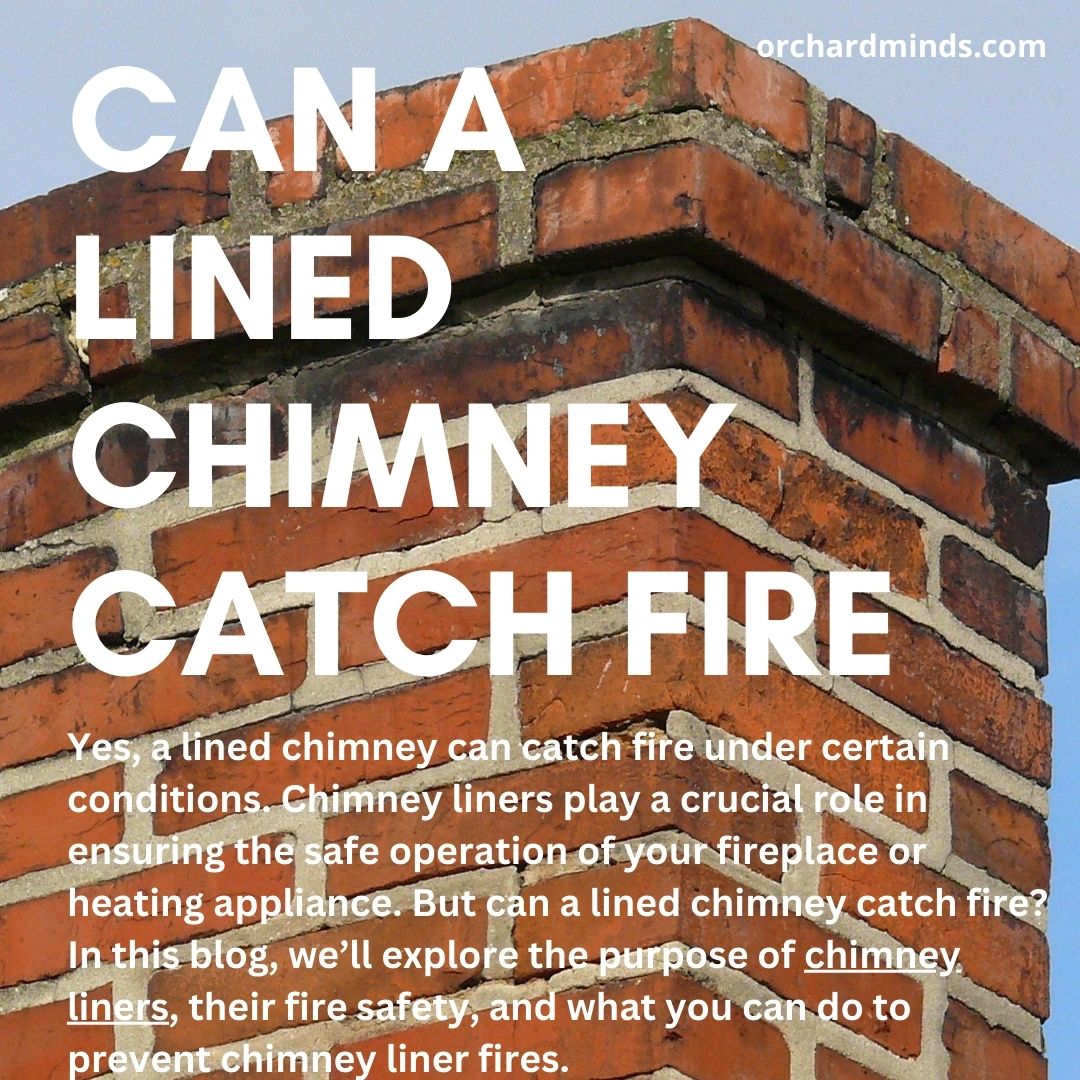Can a lined chimney catch fire
Although meant to safeguard against hazards, lined chimneys aren’t totally immune to catching fire. Designed as a protective layer between the chimney’s interior and flue gases, liners aren’t invincible to damage or breakdown over time. Cracks, excessive creosote buildup, or defects can increase the chances of fire igniting within the lined chimney. That nasty, highly flammable substance called creosote poses significant danger if not regularly cleared away. Frequent inspections, cleanings, and proper maintenance are key to reducing fire risks, ensuring your lined chimney system runs smooth and safe.
Chimney Liners & Their Function
Chimneys have a vital part called a liner. Liners shield the chimney from bad stuff that comes out when things burn. This bad stuff includes gases that can hurt the chimney, and creosote, which could catch fire. Liners give a safe, smooth path for these dangers to leave your house. They make sure the chimney doesn’t catch fire or get damaged. Liners also help the smoke and gases go up and out properly. With a liner, the burning process works better, and harmful gases can escape easily.
Types of Liners
There exist various types of chimney liners, each identified with individual features and suitability for applications. Among the most common types of chimney liners include clay tile, metal liners, such as stainless steel or aluminum, and cast-in-place liners.
Those that are made of clay tiles are time-tested, while those made of metal are preferred in most cases since they are easy to handle, and the installation process is flexible. Other types of liners include those made from casting in place, where a liner is made by pouring special cement-like material into the chimney and forms a smooth and insulated passage.
How Does a Chimney Liner Affect My Chimney?
The chimney liner has a big role in the performance and safety of the chimney. Liners, when well installed, help in preventing possible chipping off of the structure of the chimney, hence increasing life. This helps reduce the probabilities of toxic gases inside the house and, at the same time, reduces the chances of a chimney fire by containing the creosote build-up. The type of liner used in the chimney will greatly be a determinant of how efficient the draft will be, for instance, insulated liners will help in boosting the draft since they keep the flue temperatures high.
Can you have an open fire with a lined chimney?
Sure, you may light up a fire with a lined chimney. In fact, the lining of the chimney is recommended to raise safety and efficiency.
The chimney liner protects the deterrents on the walls of the chimney from the combustion by-products, which are both erosive and perilous, and it improves the draft to reduce the risk of a chimney fire. A properly lined chimney will ensure safer and more efficient operation of heating equipment, whether it is open fire, wood stove, or other heating appliances.
Do lined chimneys need to be swept?
While the lined chimney allows for extra safety, it too has to be accorded due maintenance that calls for cleaning like its counterpart. In some instances, creosote build-up persists even in the lined case and has the ability to ignite. This is an annual inspection and cleaning process by a certified chimney sweep, one that is of extreme importance. It is meant to find the liner in one piece, locate and rectify problems before they arise, and clear off the buildup in the case of creosote. The linings ensure the continual maintenance of the chimney, thus securing safe, efficient use of the equipment year in year out.
Is it safe to use an unlined chimney?
Using an unlined chimney is not recommended due to safety concerns. Unlined chimneys allow heat and byproducts of combustion to directly contact the chimney walls, increasing the risk of structural damage, fire hazards, and the release of harmful gases like carbon monoxide into living spaces. Modern building codes and safety standards often mandate the installation of chimney liners to reduce these risks. If you have an unlined chimney, it’s advisable to consult with a professional to assess the feasibility of installing a liner for improved safety and performance.
Do you need to clean a lined chimney?
Yes, even if a chimney has a liner, it still needs regular cleaning. While chimney liners provide an added layer of protection and improve the efficiency of the chimney, they can still accumulate creosote, debris, or other combustible materials over time. Regular cleaning is essential to prevent the buildup of these substances, which can pose a fire hazard and compromise the safety and efficiency of the chimney system. Professional chimney sweeps have the expertise and tools to clean both the liner and the chimney effectively.
Does a chimney with a liner need sweeping?
Yes, a chimney with a liner does require regular sweeping. The presence of a liner does not eliminate the need for cleaning. Over time, creosote, soot, and other debris can still accumulate on the interior surface of the liner. Regular chimney sweeping ensures that the flue remains clear, preventing potential fire hazards and maintaining optimal chimney performance. Sweeping also allows for the inspection of the liner’s condition, identifying any signs of damage or wear that may require repair or replacement.
How often do you need to clean a chimney liner?
The frequency of chimney cleaning, including the liner, depends on various factors such as the type of fuel burned, how often the fireplace or stove is used, and the specific conditions of use. As a general guideline, it’s recommended to have a chimney inspection and cleaning at least once a year. However, for chimneys experiencing heavier use or burning certain types of wood, more frequent cleanings may be necessary. A professional chimney sweep can assess the condition of the liner and recommend an appropriate cleaning schedule based on individual circumstances. Regular maintenance helps ensure the safety and efficiency of the entire chimney system, including the liner.
Do chimney liners need cleaning?
Yes, chimney liners do need cleaning as part of regular chimney maintenance. Over time, creosote, debris, and soot can accumulate on the interior surface of the chimney liner. This buildup can pose a fire hazard and reduce the efficiency of the chimney. Regular cleaning by a certified chimney sweep ensures that the liner remains free of obstructions and maintains proper ventilation for safe and efficient fireplace or heating appliance operation.
What happens if a chimney is not lined?
If a chimney is not lined, several issues can arise. First, without a liner, the combustible byproducts produced during the burning of fuels can directly interact with the chimney’s masonry. This interaction can lead to the deterioration of the chimney structure over time. Additionally, an unlined chimney may lack proper insulation, resulting in a higher risk of chimney fires. Moreover, the absence of a liner can lead to poor draft efficiency and an increased likelihood of creosote buildup, posing safety hazards and diminishing the overall performance of the chimney.
What is the danger of an unlined chimney?
The danger of an unlined chimney lies in its increased susceptibility to fire hazards and structural damage. Without a protective liner, the intense heat from combustion can directly affect the chimney’s masonry, leading to accelerated deterioration. This not only compromises the structural integrity of the chimney but also heightens the risk of chimney fires due to the absence of a barrier between combustible materials and the high-temperature gases produced during burning. Installing a proper chimney liner is a critical safety measure to mitigate these dangers, enhance the efficiency of the chimney, and ensure the protection of both the home and its occupants.
Can I burn wood with an unlined chimney?
Burning wood in an unlined chimney is not recommended. Chimney liners serve several crucial purposes, including containing combustion by-products, protecting the chimney walls from heat and corrosion, and enhancing draft efficiency. Without a liner, the high temperatures and corrosive by-products from burning wood can damage the chimney structure, increasing the risk of fire hazards and reducing overall safety. Installing an appropriate chimney liner is essential for safe and efficient wood-burning.
What is the best chimney liner for open fire?
For an open fire, a stainless steel chimney liner is often considered the best choice. Stainless steel liners are durable, corrosion-resistant, and capable of withstanding the high temperatures associated with open fires. They provide a smooth, insulated surface that promotes optimal draft efficiency and helps prevent the buildup of creosote, a flammable by-product of wood combustion. Additionally, stainless steel liners are versatile and suitable for various fuel types, making them a reliable option for open fireplaces. Before installation, it’s crucial to consult with a professional to ensure the liner meets local building codes and regulations.




Leave a Comment